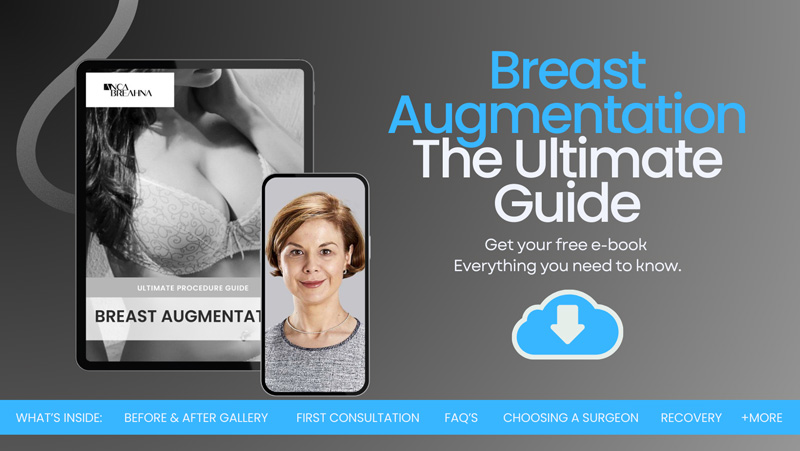
How to Treat Capsular Contracture
Capsular contracture is a condition that some people face after undergoing breast implant surgery. It involves the body’s response to the foreign objects (implants) by forming a capsule of scar tissue around them. In some instances, this capsule can tighten and squeeze the implant, leading to discomfort and changes in the appearance and feel of the breast.
This condition can affect anyone who has breast implants, regardless of the reason for the surgery. Whether for cosmetic enhancement or reconstructive purposes following mastectomy, the risk exists.
In this blog, Consultant Plastic Surgeon Anca Breahna aims to shed light on what capsular contracture is, why it occurs, and treatment options, providing a complete overview of this condition.
Download the Breast Augmentation Guide

What is Capsular Contracture?
Capsular contracture is a response by the body to the presence of breast implants. It is characterised by the formation of a thick, fibrous scar tissue capsule around the implant, which can contract and cause the breast to feel hard and look unnatural. This condition can occur in one or both breasts and varies in severity.
The formation of some scar tissue around a breast implant is a normal part of the healing process. However, in capsular contracture, this scar tissue shrinks or tightens around the implant, leading to discomfort, pain, and aesthetic changes. The reasons why some people develop a severe contracture while others do not are not fully understood, but several factors, including surgical technique and individual health, may play a role.
The stages of capsular contracture are categorised according to the Baker grading system:
- Grade I – The breast appears normal and feels soft. This stage is what surgeons aim for post-surgery.
- Grade II – The breast looks normal but feels a bit firm to the touch.
- Grade III – The breast is firm and begins to appear abnormal.
- Grade IV – The breast is hard, painful to the touch, and looks abnormal.
Early stages may not require invasive treatments and can often be managed with non-surgical options. However, more advanced cases might need surgery to correct the issue and relieve symptoms.
Causes of Capsular Contracture
Though the exact cause is often unclear, several factors have been identified that could increase the risk of developing this condition:
· Bacterial Contamination
One leading theory suggests that bacterial contamination during surgery might trigger an exaggerated healing response, leading to capsular contracture. Even a small number of bacteria, which might not cause an obvious infection, could stimulate the body to create a thicker, more constrictive scar capsule around the implant. This is why strict sterilisation techniques and antibiotic prophylaxis are crucial during implant surgery.
· Haematoma
A haematoma is a collection of blood inside the body tissues, which can occur after any surgery, including breast augmentation. If a haematoma develops around a breast implant, it can increase the risk of capsular contracture. The body’s response to the blood collection may lead to more aggressive scar tissue formation. Prompt treatment of haematomas is important to reduce this risk.
· Seroma
Similar to a haematoma, a seroma is a collection of serous fluid within the body tissues. This fluid can accumulate around the implant following surgery. While seromas often resolve on their own, their presence can increase inflammation and stimulate the formation of dense scar tissue, contributing to capsular contracture.
· Implant Type and Surface
The type of implant and its surface texture might also influence the risk of capsular contracture. There is some evidence to suggest that textured implants have a lower risk of contracture compared to smooth-surfaced implants. This is possibly due to the way the textured surface interacts with the surrounding tissue, potentially reducing the degree of scar tissue formation.
Risk Factors
While the exact cause of capsular contracture is not always clear, certain conditions and circumstances have been identified as potential risk factors. Being aware of these can help you and your surgeon to take preventative measures where possible.
Genetic Predisposition
Some individuals may have a genetic predisposition that makes them more susceptible to developing capsular contracture. This could be related to how their body responds to foreign objects and heals after surgery. Although it’s difficult to predict who will be affected, a history of excessive scarring or keloids might indicate a higher risk.
Autoimmune Disorders
People with autoimmune disorders may have an increased risk of capsular contracture. These conditions can affect how the body responds to foreign materials, including breast implants. While not all individuals with autoimmune disorders will experience capsular contracture, the altered immune response can contribute to the development of this condition.
Previous Radiation Therapy
Radiation therapy, especially when administered to the breast area, can change the characteristics of the skin and underlying tissues, making them less flexible and more prone to scarring. If breast reconstruction or augmentation is performed after radiation therapy, the risk of capsular contracture may be higher due to these changes.
Surgical Technique
The techniques used during breast implant surgery can also impact the risk of developing capsular contracture. For instance, the placement of the implant (above or below the muscle), the type of surgical incision, and how the implant pocket is handled can all influence the outcome. Anca has extensive experience in breast augmentation and adopts practices that minimise the risk of capsular contracture.
Symptoms of Capsular Contracture
The symptoms of capsular contracture can vary in intensity from person to person. Early symptoms might be subtle, but they can progress, affecting the appearance of the breasts and causing discomfort or pain.
Hardening of the Breast
One of the first and most noticeable symptoms is a hardening of the breast, which may not be accompanied by pain initially. This hardening is due to the tightening of the scar tissue capsule around the implant. Over time, this can lead to the breast feeling unnaturally firm to the touch compared to normal breast tissue or the early post-operative period.
Pain and Discomfort
As the capsule tightens further, it can cause discomfort or pain, particularly when pressure is applied to the breast or during certain movements. This discomfort can range from mild to severe and may affect daily activities or sleep patterns. Pain might also be more noticeable during physical activities or when lying in certain positions.
Aesthetic Changes
Capsular contracture can lead to visible changes in the shape and appearance of the breast. These changes might include upward displacement of the implant, distortion of the breast shape, or an uneven appearance between the two breasts. Such aesthetic changes are often what prompt women to seek medical advice.
Breast Asymmetry
If capsular contracture occurs in only one breast, or if it progresses differently in each breast, it can lead to asymmetry. One breast may appear higher, firmer, or differently shaped than the other, which can be noticeable and distressing for the individual.
Diagnosing Capsular Contracture
Diagnosing capsular contracture involves a combination of physical examinations and imaging tests. Anca uses these methods to assess the severity of the condition and to plan the best treatment approach:
Physical Examination
The initial step in diagnosing capsular contracture is a thorough physical examination. During this exam, Anca will evaluate the firmness, shape, and appearance of the breasts. Anca will also ask about any symptoms such as pain or discomfort.
Imaging Tests
Imaging tests can provide valuable information about the condition of the breast implants and the surrounding tissues.
- Mammography is sometimes used, but it can be challenging to interpret in the presence of implants and may not provide clear information about the capsule itself.
- Ultrasound is a non-invasive option that can help in identifying and evaluating the thickness of the scar tissue capsule. It can also detect fluid collections such as haematomas or seromas that might contribute to the development of capsular contracture.
- Magnetic Resonance Imaging (MRI) is considered one of the most effective tools for examining breast implants and surrounding tissues. MRI can provide detailed images, making it useful for assessing the integrity of the implant and the condition of the capsule.
In some cases, if there’s a suspicion of an underlying issue such as an implant rupture or infection, additional tests may be recommended to rule out these conditions.
Non-Surgical Treatments for Capsular Contracture
For less severe cases of capsular contracture, or when surgery is not an option, non-surgical treatments can offer relief and potential improvement.
Medications (Antibiotics and Anti-Inflammatories)
In some instances, Anca may prescribe medications to manage symptoms or attempt to reduce the severity of the capsular contracture. Antibiotics might be used if there’s a suspicion of low-grade bacterial infection contributing to the condition. Anti-inflammatory medications can help reduce swelling and discomfort, though their effectiveness in reversing capsular contracture is limited.
Physical Therapy
Physical therapy, including massage and stretching exercises, may be recommended to maintain the breast’s flexibility and manage pain. While these methods might not eliminate capsular contracture, they can provide symptom relief and improve quality of life for some individuals.
Ultrasound Therapy
Low-level ultrasound therapy has been explored as a treatment option for capsular contracture. It’s thought to help by increasing blood flow and promoting healing, which could potentially soften the scar tissue. However, results vary, and more research is needed to fully understand its effectiveness.
Surgical Treatments for Capsular Contracture
In cases where non-surgical treatments are not effective or when capsular contracture is more advanced, surgery may be necessary to address the condition:
Capsulectomy
Capsulectomy involves the surgical removal of the scar tissue capsule surrounding the implant. This procedure can be complete, where the entire capsule is removed, or partial. In many cases, the implant is replaced following the removal of the capsule to achieve the desired aesthetic outcome.
Capsulotomy
Surgical capsulotomy is a procedure where the capsule is incised or scored but not entirely removed. This can help relieve the pressure and improve the breast’s appearance and feel, though the risk of recurrence remains.
Implant Replacement or Removal
For some women, replacing the existing implant with a new one, potentially of a different type or texture, can be beneficial. In other cases, removing the implant altogether might be the preferred option, especially if the patient no longer desires to have breast implants.
FAQs about Causes and Treatment for Capsular Contracture
Can lifestyle factors influence the risk of developing capsular contracture?
- Yes, certain lifestyle factors can influence the risk of developing capsular contracture. For example, smoking can impair wound healing and increase the risk of complications following surgery, including capsular contracture. Maintaining a healthy lifestyle, including good nutrition and avoiding smoking, can help reduce the risk of capsular contracture and improve overall recovery after breast implant surgery.
Is there a difference in capsular contracture rates between cosmetic and reconstructive breast implant surgeries?
- The incidence of capsular contracture does not significantly differ between cosmetic and reconstructive breast implant surgeries. However, factors such as the type of surgery (e.g., mastectomy followed by reconstruction), the use of radiation therapy in cancer treatments, and the surgical technique can influence the individual risk of developing capsular contracture.
Can changing the implant type or position prevent recurrence of capsular contracture?
- Yes, in cases where capsular contracture has occurred, changing the implant type (e.g., from silicone to saline or vice versa) or its position (e.g., from subglandular to submuscular placement) during revision surgery may help reduce the risk of recurrence. Each case is unique, so the decision should be made in consultation with Anca who can evaluate the specific circumstances and recommend the best approach.
Are there any new treatments on the horizon for capsular contracture?
- Research into the causes and treatment of capsular contracture is ongoing, and new treatments are being explored. These include the use of certain medications that might affect the biological processes leading to scar tissue formation and the development of new implant materials and coatings that could minimise the body’s reactive scarring.
How long after breast implant surgery can capsular contracture develop?
- Capsular contracture can develop at any time after breast implant surgery, from within a few months to several years post-operation. The risk varies over time, with some cases occurring early in the post-operative period and others developing much later. Regular follow-up visits with Anca can help detect any changes early, facilitating timely intervention if necessary.
Further Reading about Breast Surgery with Chester Consultant Plastic Surgeon Anca Breahna
- Read more about Do I Need a Post Op Bra after Breast Surgery?
- Read more about All about Perfect Breasts and How to Get Them
- Read more 10 Things to Consider Before a Breast Reduction
- Read more about How to Fix Saggy Breasts – Breast Uplift, Breast Implants or Both
- Read more about Solutions for Uneven Breasts
Medical References about Causes and Treatment for Capsular Contracture
- Nonsurgical treatment of capsular contracture -PubMed
- Capsular Contracture after Breast Augmentation – PubMed
- A literature review and summary of capsular contracture – Science Direct
- Capsular Contracture: Etiology and Treatment Options – Research Gate
- What is capsular contracture and how can it be treated? – American Society



 Ms Anca Breahna, PhD, MSc, FEBOPRAS, FRCS (Plast) is a highly regarded Consultant Plastic Surgeon specialising in the field of Aesthetic and Reconstructive Plastic Surgery. Anca performs a range of breast, body and face surgery and minor skin procedures.
Ms Anca Breahna, PhD, MSc, FEBOPRAS, FRCS (Plast) is a highly regarded Consultant Plastic Surgeon specialising in the field of Aesthetic and Reconstructive Plastic Surgery. Anca performs a range of breast, body and face surgery and minor skin procedures.